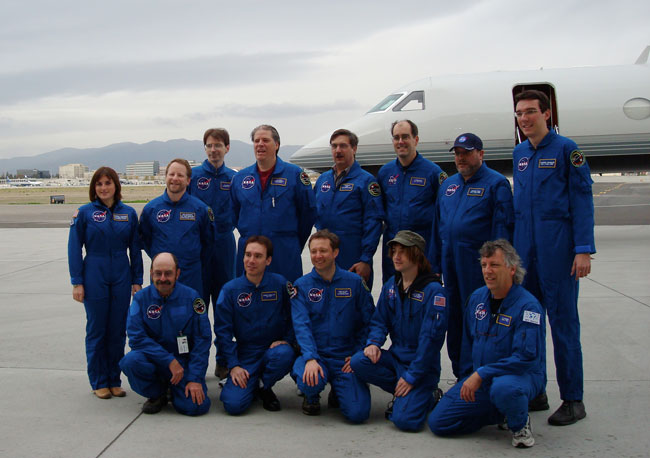Hard-To-See Meteor Shower Observed from Arctic

On the eveningof January 3, 2008, NASA Ames Research Center and SETI Institute hosted anairborne observing campaign that took an international team of 14 researchers abovethe Arctic Circle and back in a privately owned Gulfstream V aircraft for anunprecedented view of a mysterious meteor shower called the "Quadrantids."The first impressions, images, and predictions are posted at the QuadrantidMulti Instrument Aircraft Campaign (Quadrantid MAC) mission website.
For eighthours, six visual observers scanned the video output of four intensifiedcameras that were aimed low above the crystal-clear horizon. We counted meteorsand the tally provided our first solid glimpse at the fascinating origin andhistory of the Quadrantid meteor shower. We found the highest rates occurredaround 8h UT. This is later than all of our advance predictions (02:00 UT to07:37 UT), which has caused some head scratching among the modelers in ourteam.
We observedthese natural New Yearfireworks from a lofty altitude of 47,000 ft. during a peculiar roundtripfrom the Bay Area to the Bay Area, via the Arctic Circle. The mission departed duringone of the strongest rainstorms to hit the area in two years. When the aircraftemerged from the cloud deck, the sky was brilliantly clear and remained sothroughout the mission. The view over the horizon provided a large surface areafor spotting Quadrantid meteors, little dimmed by the low atmospheric extinctionat altitude.
The missionpath was designed to compensate for the rotation of the Earth and kept theshower in view throughout the mission. Observers on the ground are plagued bythe fact that the Quadrantids are mostly a daytime shower, disappearing fromview around midnight when the radiant of the shower sinks below the horizon,only to appear again in the early morning hours. The Quadrantid shower is onlyabout 8 hours wide at half the peak rate. The shower is impressive only whenthe peak happens to occur in the early morning hours at your local site. Atthat time, it can outshine other strong annual showers including the Perseidsand Geminids.
By flyingnorth when the radiant was about to set, and returning south when the radiantwas again rising, we kept the radiant at an elevation between 15 and 30 degreesthroughout the mission. This meant that the Quadrantids were entering theatmosphere at a shallow angle and created long-lasting and slow-moving meteors.We counted some 846 of these shooting stars during the flight. This was thevery first time that the Quadrantid shower was observed under nearly constant conditionsfor the entire period during which the peak might occur.
TheQuadrantid shower is caused by a steeply inclined sheet of meteoroids thatstretches from Earth's orbit to the orbit of Jupiter, where the heavy planetfrequently scatters the meteoroid orbits in and out of Earth's path. Potentially,this can lead to large variations in peak activity and in peak time. Our goalfor the mission was to start disentangling those effects from the reportedvariations caused by the difficult and changing observing conditions on theground.
How muchinfluence Jupiter has depends on how much dispersion the Quadrantid orbits haveaccumulated over time. The dispersion depends on the age of the shower and howthe stream was created. Like most of our meteor showers, the stream appears tohave been created in a breakup of a comet,instead of from a slow and gradual oozing out of water vapor. Likely, themassive stream is younger than 500 years. About 500 years ago, in A.D. 1490-91,Chinese observers reported a comet moving in the same plane as that of theQuadrantids. We are now investigating whether or not this comet C/1490 Y1represents the moment in time that the Quadrantid parent body broke and createdthe massive stream. In 2003, we discovered that a minor planet called"2003 EH1" moves among the meteoroids. This now-dormant remnant ofthe breakup provides an anchor to investigate the origin and evolution of thestream, but the current models that predict how the stream manifests 500 years laterare clearly insufficient.
Breaking space news, the latest updates on rocket launches, skywatching events and more!
Our teamcollected other evidence about the origin of the stream. The 2008 Quadrantid MACmission deployed a total of 25 cameras of various sorts and purposes. Wemeasured spectra for main element composition of the dust, light curves toinvestigate how the grains break upon entering the atmosphere, and meteoroidsize distributions to understand the fragmentation processes during formationof the stream.
We thankall the individuals and organizations that made this mission possible. Once we understandwhat happened in 2008, we all hope to verify that with another Quadrantid MACmission some time in the future.
- Video: A Meteoric Tale
- Video: Killer Comets and Ominous Asteroids!
- Video of the 2001 Leonid Meteor Shower
- All About Meteors
Peter is a distinguished Dutch-American astronomer and senior research scientist at the Carl Sagan Center of the SETI Institute and at NASA Ames Research Center. He is a noted expert on meteor showers, meteor falls, and artificial meteors who also wrote the books "Meteor Showers and Their Parent Comets from 2006 and "Atlas of Earth's Meteor Showers from 2023. He's a graduate of Leiden University where he obtained his M.S. and Ph.D.
